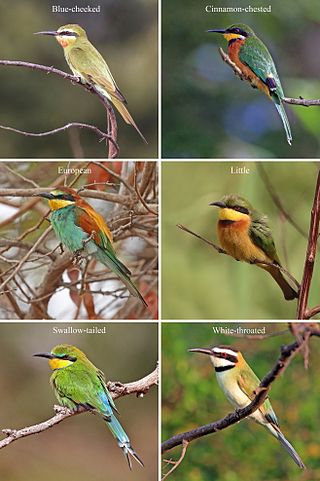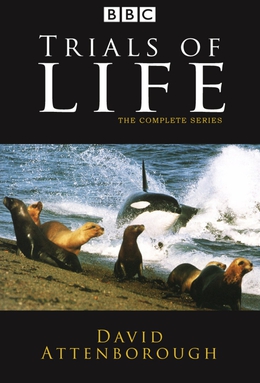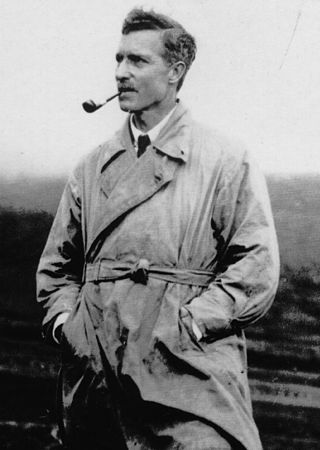Related Research Articles

Birds are a group of warm-blooded vertebrates constituting the class Aves, characterised by feathers, toothless beaked jaws, the laying of hard-shelled eggs, a high metabolic rate, a four-chambered heart, and a strong yet lightweight skeleton. Birds live worldwide and range in size from the 5.5 cm (2.2 in) bee hummingbird to the 2.8 m common ostrich. There are about ten thousand living species, more than half of which are passerine, or "perching" birds. Birds have wings whose development varies according to species; the only known groups without wings are the extinct moa and elephant birds. Wings, which are modified forelimbs, gave birds the ability to fly, although further evolution has led to the loss of flight in some birds, including ratites, penguins, and diverse endemic island species. The digestive and respiratory systems of birds are also uniquely adapted for flight. Some bird species of aquatic environments, particularly seabirds and some waterbirds, have further evolved for swimming.

Hang gliding is an air sport or recreational activity in which a pilot flies a light, non-motorised foot-launched heavier-than-air aircraft called a hang glider. Most modern hang gliders are made of an aluminium alloy or composite frame covered with synthetic sailcloth to form a wing. Typically the pilot is in a harness suspended from the airframe, and controls the aircraft by shifting body weight in opposition to a control frame.

The bee-eaters are a group of non-passerine birds in the family Meropidae, containing three genera and thirty species. Most species are found in Africa and Asia, with a few in southern Europe, Australia, and New Guinea. They are characterised by richly coloured plumage, slender bodies, and usually elongated central tail feathers. All have long down-turned bills and medium to long wings, which may be pointed or round. Male and female plumages are usually similar.

Karl Rudolf Gerd von Rundstedt was a German field marshal in the Heer (Army) of Nazi Germany during World War II. Born into a Prussian family with a long military tradition, Rundstedt entered the Prussian Army in 1892. During World War I, he served mainly as a staff officer. In the inter-war years, he continued his military career, reaching the rank of Colonel General before retiring in 1938.

Falconry is the hunting of wild animals in their natural state and habitat by means of a trained bird of prey. Small animals are hunted; squirrels and rabbits often fall prey to these birds. Two traditional terms are used to describe a person involved in falconry: a "falconer" flies a falcon; an "austringer" flies a hawk or an eagle. In modern falconry, the red-tailed hawk, Harris's hawk, and the peregrine falcon are some of the more commonly used birds of prey. The practice of hunting with a conditioned falconry bird is also called "hawking" or "gamehawking", although the words hawking and hawker have become used so much to refer to petty traveling traders, that the terms "falconer" and "falconry" now apply to most use of trained birds of prey to catch game. Many contemporary practitioners still use these words in their original meaning, however.

The red-winged blackbird is a passerine bird of the family Icteridae found in most of North America and much of Central America. It breeds from Alaska and Newfoundland south to Florida, the Gulf of Mexico, Mexico, and Guatemala, with isolated populations in western El Salvador, northwestern Honduras, and northwestern Costa Rica. It may winter as far north as Pennsylvania and British Columbia, but northern populations are generally migratory, moving south to Mexico and the Southern United States. Claims have been made that it is the most abundant living land bird in North America, as bird-counting censuses of wintering red-winged blackbirds sometimes show that loose flocks can number in excess of a million birds per flock and the full number of breeding pairs across North and Central America may exceed 250 million in peak years. It also ranks among the best-studied wild bird species in the world. The red-winged blackbird is sexually dimorphic; the male is all black with a red shoulder and yellow wing bar, while the female is a nondescript dark brown. Seeds and insects make up the bulk of the red-winged blackbird's diet.

The emperor penguin is the tallest and heaviest of all living penguin species and is endemic to Antarctica. The male and female are similar in plumage and size, reaching 100 cm (39 in) in length and weighing from 22 to 45 kg. Feathers of the head and back are black and sharply delineated from the white belly, pale-yellow breast and bright-yellow ear patches.

The American white ibis is a species of bird in the ibis family, Threskiornithidae. It is found from Virginia via the Gulf Coast of the United States south through most of the coastal New World tropics. This particular ibis is a medium-sized bird with an overall white plumage, bright red-orange down-curved bill and long legs, and black wing tips that are usually only visible in flight. Males are larger and have longer bills than females. The breeding range runs along the Gulf and Atlantic Coast, and the coasts of Mexico and Central America. Outside the breeding period, the range extends further inland in North America and also includes the Caribbean. It is also found along the northwestern South American coastline in Colombia and Venezuela. Populations in central Venezuela overlap and interbreed with the scarlet ibis. The two have been classified by some authorities as a single species.

The laughing kookaburra is a bird in the kingfisher subfamily Halcyoninae. It is a large robust kingfisher with a whitish head and a brown eye-stripe. The upperparts are mostly dark brown but there is a mottled light-blue patch on the wing coverts. The underparts are cream-white and the tail is barred with rufous and black. The plumage of the male and female birds is similar. The territorial call is a distinctive laugh that is often delivered by several birds at the same time, and is widely used as a stock sound effect in situations that involve a jungle setting.

The pied kingfisher is a species of water kingfisher widely distributed across Africa and Asia. Originally described by Carl Linnaeus in 1758, it has five recognised subspecies. Its black and white plumage and crest, as well as its habit of hovering over clear lakes and rivers before diving for fish, make it distinctive. Males have a double band across the breast, while females have a single gorget that is often broken in the middle. They are usually found in pairs or small family groups. When perched, they often bob their head and flick up their tail.

The northern gannet is a seabird, the largest species of the gannet family, Sulidae. It is native to the coasts of the Atlantic Ocean, breeding in Western Europe and Northeastern North America. It is the largest seabird in the northern Atlantic. The sexes are similar in appearance. The adult northern gannet has a mainly white streamlined body with a long neck, and long and slender wings. It is 87–100 cm long with a 170–180 cm (67–71 in) wingspan. The head and nape have a buff tinge that is more prominent in breeding season, and the wings are edged with dark brown-black feathers. The long, pointed bill is blue-grey, contrasting with black, bare skin around the mouth and eyes. Juveniles are mostly grey-brown, becoming increasingly white in the five years it takes them to reach maturity.

The southern ground hornbill is one of two species of ground hornbill, both of which are found solely within Africa, and is the largest species in the hornbill order worldwide. It can be found in the southern regions of Africa, ranging from Kenya to South Africa. Within these regions, they inhabit both woodlands and savannas. The other species of the genus Bucorvus is the Abyssinian ground hornbill, B. abyssinicus.

The Trials of Life: A Natural History of Behaviour is a BBC nature documentary series written and presented by David Attenborough, first transmitted in the United Kingdom from 3 October 1990.

The greater honeyguide is a bird in the family Indicatoridae, paleotropical near passerine birds related to the woodpeckers. Its English and scientific names refer to its habit of guiding people to bee colonies. Claims that it also guides non-human animals are disputed.

Colonel Richard Meinertzhagen, CBE, DSO was a British soldier, intelligence officer, and ornithologist. He had a decorated military career spanning Africa and the Middle East. He was credited with creating and executing the Haversack Ruse in October 1917, during the Sinai and Palestine Campaign of the First World War, but his participation in this matter has since been refuted.

The tawny eagle is a large bird of prey. Like all eagles, it belongs to the family Accipitridae. Its heavily feathered legs mark it as a member of the subfamily Aquilinae, also known as booted eagles. Tawny eagles have an extensive but discontinuous breeding range that constitutes much of the African continent as well as the Indian subcontinent, with rare residency in the southern Middle East. Throughout its range, it favours open dry habitats such as semideserts, deserts steppes, or savanna plains. Despite its preference for arid areas, the species seldom occurs in areas where trees are entirely absent. It is a resident breeder which lays one to three eggs in a stick nest most commonly in the crown of a tree. The tawny eagle is perhaps the most highly opportunistic of all Aquilinae, and often scavenges on carrion or engages in kleptoparasitism towards other carnivorous animals but is also a bold and active predator, often of relatively large and diverse prey. It is estimated that tawny eagles can reach the age of 16 years old. Nonetheless, precipitous declines have been detected throughout the tawny eagle's range. Numerous factors, particularly loss of nesting habitat due to logging and global warming, as well as persecution and other anthropogenic mortality are driving the once numerous tawny eagle perhaps to the brink of extinction.

Hussein, Hussain, Hossein, Hossain, Huseyn,Husayn, Husein or Husain, coming from the triconsonantal root Ḥ-S-N, is an Arabic name which is the diminutive of Hassan, meaning "good", "handsome" or "beautiful". It is commonly given as a male given name, particularly among Shias. In Persian language contexts, the transliterations Ḥosayn, Hosayn, or Hossein are sometimes used. In the transliteration of Indo-Aryan languages, the forms "Hussain" or "Hossain" may be used. Other variants include Husên, Husejin, Husejn, Husain, Hisên, Hussain, Husayin, Hussayin, Hüseyin, Husseyin, Huseyn, Hossain, Hosein, Husseyn (etc.). The Encyclopaedia of Islam, which follows a standardized way for transliterating Arabic names, used the form "Ḥusain" in its first edition and "Ḥusayn" in its second and third editions.

The purple martin is a passerine bird in the swallow family Hirundinidae. It is the largest swallow in North America. Despite its name, the purple martin is not truly purple. The dark blackish-blue feathers have an iridescent sheen caused by the refraction of incident light giving them a bright blue to navy blue or deep purple appearance. In some light they may even appear green in color.

This is a 2015 timeline of events in the Somali Civil War (2009–present).

Human uses of birds have, for thousands of years, included both economic uses such as food, and symbolic uses such as art, music, and religion.
References
- ↑ "Resurgence • Article - Guides and Gatherers". www.resurgence.org. Retrieved 2017-11-16.
- ↑ Tucker, Vance A. (1991). "The Effect of Molting on the Gliding Performance of a Harris' Hawk (Parabuteo unicinctus)". The Auk. 108 (1): 108–113. JSTOR 4088054.
- ↑ Die moderne Biologie und das Verhältnis zwischen-Hans Ulrich Reyer
- ↑ Winged Messengers: The Decline of Birds
- ↑ "Ewaso Nyiro - :: Water Resource Management Authority (WRMA) ::". Archived from the original on 2013-07-19. Retrieved 2013-08-24.
- ↑ Attenborough, David; Gunton, Michael; Fenton, George; Kingsland, Paddy; Boesch, Christophe; Franks, Nigel R.; Moss, Cynthia; Fisher, Paul; Woolfenden, Glen Everett (1993), The Making of The trials of life, Turner Home Entertainment, ISBN 0780603516, OCLC 029975767